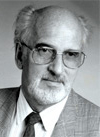Hans Oeschger

Hans Oeschger was born in Ottenbach near Zürich, Switzerland, on April 2, 1927. Trained as a nuclear physicist at ETH Zürich, he obtained his PhD at the University of Bern under the guidance of Professor F. G. Houtermans for the development of a device to measure weak radioactivity. This counter, now referred to as "Oeschger Counter", had a lower background than any other available instrument which enabled the application of the carbon-14 method to new geophysical problems. In 1963 Hans Oeschger was promoted to Professor at the University of Bern and founded the Laboratory for Low Level Counting and Nuclear Geophysics. He directed the laboratory, the Division of Climate and Environmental Physics, until his retirement in 1992.
Hans Oeschger was a pioneer in ice core research. In 1962 he determined the tritium content of old firn and ice, and thereby utilized them as archives of environmental information. The analytical methods, as well as the drilling techniques, which Oeschger and his team developed and employed in numerous expeditions to Greenland and Antarctica since 1964, allowed them to produce an unprecedented reconstruction of climate changes of the last 150,000 years. In collaboration with "the Bern team" he was the first to measure the glacial-interglacial change of atmospheric CO2. They showed in 1979 that the atmospheric concentration of CO2 during the glacial was almost 50% lower than today. Furthermore, they analysed the CO2 changes during the last 1000 years and demonstrated that the dramatic increase of the last 200 years was a direct consequence of the burning of fossil fuels. These two results are now cornerstones of global change research. Hans Oeschger was deeply troubled by the possibility of an increased greenhouse effect caused by the steady increase of atmospheric CO2. He was a concerned citizen who took seriously his responsibility as a scientist towards society. He said: The worst for me would be, if there were serious changes in the next 5 to 10 years and we scientists are helpless and did not have the courage to point at these dangerous developments early.
However, Hans Oeschger extracted even more surprises from the polar ice cores. Together with his colleagues Chester C. Langway (USA) and Willi Dansgaard (DK), he documented a series of abrupt climate changes in the Greenland ice cores. Stable isotope measurements on carbonates in Lake Gerzensee (near Bern) demonstrated that these abrupt changes are not only local or regional changes in Greenland but they are large climatic changes of at least hemispheric extent. Today 24 of these events have been documented during the last glacial. These are now known as the Dansgaard-Oeschger Events, and they are found in many different paleoclimate archives. Already in 1984, Oeschger recognised the important role of the ocean circulation for an explanation of such abrupt climate change and used the physical analogy of a flip-flop system. Triggered by small perturbations, the ocean circulation could switch from one mode of operation to another.
Hans Oeschger considered the Earth as a system. Its processes can be understood by scientists only if they are open to new ways of approaching the problems. Oeschger crossed the disciplinary boundaries long before inter- and transdisciplinarity have become buzz words. However, he was also firm in pointing out the fact that successful transdisciplinary research requires continued inspiration from the disciplinary research at the highest level. The wide respect for Hans Oeschger's work is not least based on his fundamental contributions to physics during many years.
His scientific achievements were widely honored. He received the Harold Urey Medal (1987), the Seligman Crystal (1991), the Marcel-Benoist Prize (1991), the Tyler Prize for Environmental Achievement (1996) and the Revelle Medal of the American Geophysical Union (1997). He was Member of the Leopoldina, the Academia Europaea and a foreign Member of the US Academy of Sciences.
Hans was excellent in conveying his enthusiasm for the scientific quest to understand the Earth System in its entire complexity to his colleagues and students. Modern environmental physics owes much to Hans Oeschger. His contributions to paleoclimatology made this initially descriptive field a quantitative science, in which changes of environmental conditions are given numbers and units.
Thomas Stocker
Climate and Environmental Physics
University of Bern
19 December 2001
